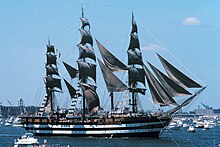Full-rigged ship
[1] Such a vessel is said to have a ship rig or be ship-rigged, with each mast stepped in three segments: lower, top, and topgallant.Unlike the corresponding yards on the fore and main mast it did not usually have fittings to hang a sail from: its purpose was to control the lower edge of the topsail.Additionally, the great size of some late-19th and 20th century vessels meant that their correspondingly large sails would have been impossible to handle had they not been divided.They are named after the adjacent sail and the side of the vessel on which they are set, for example main topgallant starboard stu'nsail.[5] This allows the crew to stop and quickly restart the ship without retracting and lowering the sails, and to dynamically compensate for the push of the wind on the masts themselves and the yards.





Christian RadichRoyal ClipperAmerigo VespucciMarina Militaresailing vesselsail plansquare-riggedfore-and-aft sailHMS Lutinecourse saillateengaff sailspankerbarqueTopsailTopgallant sailRoyal sailSkysailMoonrakerjib-boomStaysailsCarrackfurledstudding sailsspankersGlossary of nautical terms (A-L)Glossary of nautical terms (M-Z)RiggingSail-planTypes of sailing shipsWillaumez, Jean-Baptiste-PhilibertW. W. Norton & CompanysailingAge of SailMaritime historyAge of DiscoveryNavigationBermuda rigCrab clawFore-and-aft rigGaff rigGunter rigJunk rigLateen rigLjungström rigLug rigMast aft rigPinisi rigSquare rigTanja rigsailing rigsBarquentineBrigantineCatboatCutterJackass-barqueMisticoSchoonerMultihullʻaliaAmatasiBauruaCamakauCatamaranGuilaloJukungKarakoaKora koraLakatoiLanongOutrigger canoePentamaranQuadrimaranTepukeiTipairuaTongiakiTrimaranUngalawaVa'a-teleVaka kateasailing shipsAncientBalangayBorobudur shipFire shipGalleyPenteconterBiremeTriremeQuadriremesTessarakonteresDromonK'un-lun poPost-classicalBalingerBenawaBirlinnBomb vesselKonduraLongshipMalangbangShitikTongkangChinese treasure shipCaravelGhurabLancaranTrabaccoloCrommestevenGaliotGalleonGalleassFlyboatFull-rigged pinnaceLorchaMan-of-warManchuaPatacheSperonaraSquare-rigged caravel (round or de armada)Bermuda sloopCorvetteEast IndiamanFrigateGaleasPolacca